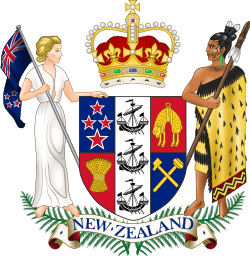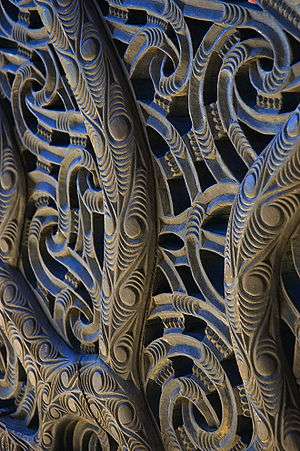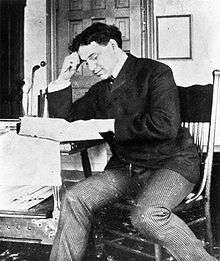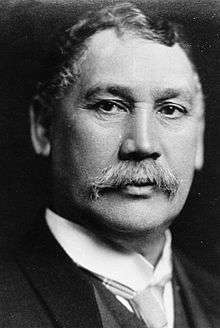Māori politics
 |
| This article is part of a series on the politics and government of New Zealand |
| Constitution |
|
|
|
|
Related topics |
Māori politics is the politics of the Māori people, who were the original inhabitants of New Zealand and who are now the country's largest minority. Modern Māori politics can be seen as a subset of New Zealand politics in general, but has a number of distinguishing features.
Pre-colonial Māori governance
Before the arrival of Pākehā (European settlers) in New Zealand, Māori society was based largely around communal units. A common misconception is that pre-colonial Māori governance was structured into the "rigid and static structural models" (p. 19)[1] proposed by early ethnologists, such as Elsdon Best (1934):
The tribal organisation of the Maori included three different groups – the tribe (iwi), the clan (hapu), and the family group (whanau).... The clan or sub-tribe was composed of a number of family groups, and the sum of the clans (hapu) formed the tribe. (p. 89)[2]
Twentieth century research "modified this model of tribal organisation, emphasising the role of the hapū ... as the largest effective corporate group which defended a territory or worked together in peaceful enterprises" (p. 19).[3] Therefore, it is now understood that hapū were responsible for administering resources, land, and important community buildings, and were also responsible for warfare (particularly maintaining the waka). The iwi typically functioned more as a federation than as an administrative structure.
Political leadership or governance in Māori society has traditionally come from two different groups of people – the Ariki and the Rangatira. The Ariki are "persons of the highest rank and seniority" (p. 58).[4] Ariki did not operate in simple hierarchical orgranisations; despite what later "government officers were inclined to believe", Ariki have never been "the apex of a structured hierarchy of institutionalised tribal authority" (p. 264).[5] Many positions overlap with Ariki holding multiple roles, including "head of an iwi, the rangatira of a hapu and the kaumatua of a whanau" (p. 197).[6]
The Rangatira are the hereditary Māori leaders of hapū, often described by Europeans as chieftains. They are typified by their "humility, leadership, diplomacy, generosity, integrity and honesty" (p. 4).[7]
Entry of Māori to colonial politics

The Treaty of Waitangi, signed between various Māori iwi and the British crown, had the practical effect of transferring sovereignty to the United Kingdom. (It is debated as to whether this was the intent of the Māori, and whether this was what the treaty actually said.) Māori were granted all the rights of British subjects.
As settlement increased, the colonists became increasingly vocal in their call for self-government. Eventually, in 1852, the British government passed the New Zealand Constitution Act, establishing an elected Parliament of New Zealand. Responsible government, where this Parliament had the authority to appoint Cabinet, was achieved a few years later. At first, Māori had little interest in the new Parliament, seeing it as a Pākehā institution with no real relevance to them. Later, however, there was an increasing desire by Māori to participate in Parliament – the New Zealand Land Wars of the 1860s, coupled with ongoing land seizures, convinced many Māori that the "settler Parliament" now had a major impact on them, and that their voices needed to be heard in it.
In theory, there was never any law barring Māori from election to Parliament, nor barring them from voting. In practice, however, other laws made it virtually impossible. The major stumbling block was the property qualification, which required voters to own a certain amount of land. While Māori owned a large portion of New Zealand, most of this was held in common, not under individual title. As such, few individual Māori met the property requirement personally – even if they were part-owners of vast amounts of land, they did not have any land which they owned exclusively, and so did not qualify to vote.
In 1867, however, Parliament passed the Māori Representation Act, which created four special electorates for Māori.[8] These seats did not have a property qualification. The creation of the seats was controversial, being opposed by those Pākehā who saw Māori as uncivilised. It was also opposed by a small group which felt that by creating separate Māori electorates, Māori would be sidelined, as Pākehā politicians would not have to consult Māori opinion as they would if Māori voted in general electorates. There was also debate about the number of seats – if Māori had been given a number of seats equivalent to their population, they would have had around fifteen seats, not four. One of the more radical MPs in Parliament, James FitzGerald, actually called for Māori to be given a third of the seats in Parliament, but this was widely seen as excessive. In the end, the seats were approved based mainly on a desire to improve relations with Māori and reduce military conflict. The first Māori MPs took their seats in 1868.
What are these four to do among so many Pakehas; where will their voices be as compared with the Pakeha voices?
Ngāpuhi prophet Āperahama Taonui protesting that Māori were only to have four seats[8]
It was intended that these seats would eventually be abolished as Māori abandoned traditional land ownership traditions. In the end, however, the seats were retained, and still exist today.[8] There have, over the years, been a number of attempts to abolish them, with a number of different reasons being given – some said that reserving seats was unfair, while others said that keeping Māori electorates separate meant that Māori were marginalised and ignored by mainstream politicians. Many Māori politicians defended the electorates, saying that they were necessary to ensure Māori representation in Parliament. Other Māori leaders, however, said that the seats were not required – there have been Māori politicians who have gained election in non-Māori seats.
Māori in mainstream parties


When Māori MPs were first elected to Parliament, there were no formal political parties in New Zealand. After the Liberal Party was founded, however, it gained the support of a number of prominent Māori figures. The most prominent Māori to serve as a Liberal MP was Apirana Ngata, who rose high within the Liberal Party's hierarchy. Ngata is said by many to be the most prominent Māori MP ever, and he is featured on New Zealand's fifty-dollar bill. The Liberal Party did not have an exclusive control of the Māori electorates, however – Maui Pomare, another prominent Māori politician, was a member of the conservative and rural Reform Party, as were Taurekareka Henare and Taite Te Tomo. The Young Māori Party supported political action, but it was not a formal party.
In the 1930s, new movements began to arise in Māori politics. In particular, the Ratana church expanded its political participation, standing candidates for Parliament. In the 1935 elections, Ratana won two of the four Māori electorates. The Ratana MPs did not remain independent for long, however – they quickly merged into the Labour Party, which they saw as best addressing Māori needs. By 1943, the Labour/Ratana alliance had won all four Māori electorates, establishing a pattern of dominance that many people thought was unbreakable. Among the most prominent Māori MPs in the Labour Party were Eruera Tirikatene, who was succeeded by his daughter, Whetu Tirikatene-Sullivan – both represented Southern Maori in Parliament for several decades.

Despite Labour's dominance of the Māori vote, the National Party, Labour's main opponent, occasionally elected Māori MPs in general electorates. Ben Couch (Wairarapa) and Rex Austin (Awarua), were elected in 1975, the second and third Māori elected to a general seat (after Sir James Carroll in 1893). Winston Peters, elected to Tauranga in 1984 (he had previously stood for Northern Maori) is half Māori.
In the 1996 elections, a major shift in Māori politics occurred when Labour lost all the Māori seats (of which there were now five) to the New Zealand First party. New Zealand First, while not a Māori party, has a strong Māori wing, and its leader, Winston Peters (originally of the National Party), is half Māori. New Zealand First's clean sweep of the Māori seats surprised many observers, who had believed that Labour's grip was too strong to be broken. In the 1999 elections, Labour won all the Māori electorates back again, but the traditional Māori allegiance to Labour has been re-evaluated – Labour cannot, most observers say, simply take Māori support for granted.
Since the advent of the MMP electoral system, Māori representation in Parliament has increased – Māori are able to be elected as list MPs, bypassing the problem of securing an electorate. This has been particularly noticeable in parties which have traditionally contained few Māori – MPs such as Georgina Te Heuheu in the National Party and Donna Awatere Huata in the ACT party are not likely to have entered Parliament without MMP, given the difficulty that their parties would face contesting the Māori electorates. At present, there are ten Māori electorate MPs (seven in Māori electorates and three in general seats) and nine Māori list MPs. Māori make up around 16% of Parliament, slightly higher than their proportion of the population. The introduction of MMP brought further calls for the abolition of the Māori electorates, which many deemed unnecessary in the new system.
Māori parties
Throughout the history of Māori participation in mainstream parties, there have been those who argue that Māori cannot truly be represented unless they have a separate group. In recent years, with the resurgence of Māori culture, these calls have increased. In 1979, a Labour MP, Matiu Rata, quit the party to form his own group, saying that Māori could not succeed if they were simply a component of a larger group. Later, Tuariki Delamere would say much the same thing, claiming that "you cannot be accountable to Māori if your first allegiance is to a political vehicle that is owned and controlled by Pākehā." Most recently, Tariana Turia has broken from the Labour Party to co-found the new Māori Party, which won four of the seven Māori seats in the 2005 election which were held by the Labour party, and a fifth Māori seat in the 2008 election. The Māori Party entered a confidence and supply agreement with the Fifth National Government in 2008, and two of its MPs became Ministers outside Cabinet in that Government.
Below are some of the parties which have been based around Māori voters, or which are sometimes seen as such.
Mana Motuhake
Mana Motuhake, roughly translated as "self-government", was founded in 1979 as an independent Māori party by Labour MP Matiu Rata. Rata resigned from Parliament to contest a by-election under Mana Motuhake's banner, but was not re-elected. The party tried for some time to win the Māori seats, but was never elected to Parliament. In 1991, Mana Motuhake joined the Alliance, a broad left-wing coalition. Under the Alliance, several Mana Motuhake members, including Sandra Lee-Vercoe and Willie Jackson, were elected to Parliament. When the Alliance split, Mana Motuhake remained with the hardline faction, which failed to retain any seats in Parliament. Mana Motuhake has since left the Alliance.
Mana Māori Movement
The Mana Māori Movement was founded by Eva Rickard, a former candidate of Mana Motuhake. Rickard objected to the decision by Mana Motuhake to join the Alliance, believing that a completely independent Māori party was required. Mana Māori contested the Māori seats, but never won a place in Parliament. In the most recent elections, it worked in coalition with Te Tawharau and Piri Wiri Tua.
Mana Wahine
Mana Wahine Te Ira Tangata, founded by former Alliance (Mana Motuhake) MP Alamein Kopu, stated its goal as promoting and protecting the interests of Māori women. Many of its opponents, however, claimed that the party was born out of Kopu's "opportunism", and denied that it had any real ideological commitment. Kopu was not re-elected.
Mauri Pacific
Mauri Pacific, founded by five former New Zealand First MPs, denied that it was a Māori party, saying instead that it was merely "multiculturalist". It did, however, have policies that were strongly favourable towards Māori, and three of its five MPs (including its leader) were of Māori descent. This contributed to a widespread perception of it as a Māori party. The similarity of "Mauri" and "Māori" likely strengthened this view, although the words are unrelated. None of the party's MPs were re-elected, and it has since dissolved.
Te Tawharau
Te Tawharau is a small Māori party which briefly held a seat in Parliament when Tuariki Delamere, a former New Zealand First MP, joined it. Delamere believed that an independent Māori voice was essential, saying that New Zealand First had tried and failed to balance Māori interests with other concerns. Delamere was not re-elected.
Piri Wiri Tua
The Piri Wiri Tua Movement is a small party based around the teachings of the Ratana church.
Māori Party
The Māori Party is a Māori political organisation, and is currently the best performing. It was founded around Tariana Turia, a Labour MP who quit her party over the foreshore and seabed controversy, which Turia claims is seeing Māori deprived of their rights. She shares the party leadership with Pita Sharples, a Māori academic. The Māori Party hoped to win all seven Māori seats in the next election, in 2005, although eventually won only four. Polls leading up to the election widely expected this – particularly for Labour MPs Nanaia Mahuta and Parekura Horomia to hold their seats. The party gained another seat in the 2008 election, although their share of the party vote remained low, with many Māori voters splitting their vote between a Māori Party MP and the Labour Party. After the 2008 election, the Māori Party agreed to support a minority National government on matters of confidence and supply, gaining ministerial posts for its co-leaders and commitments regarding the Māori seats and the foreshore and seabed legislation.[9]
Mana Movement
The Mana Movement is a New Zealand political party led by Hone Harawira which was formed in April 2011 following Hone Harawira's resignation from the Māori Party. Hone Harawira won the by-election in Te Tai Tokerau of 25 June 2011 for the Mana Party, and went on to retain this seat during the 2011 general election. The party lost its one-seat during the 2014 election. The decision to work with the Internet Party is largely blamed for the loss because of the concerns people had with Internet Party's founder, and financier, Kim Dotcom.
Māori politicians
Terminology used in Māori politics
- Mana – prestige, honour, respect, dignity, integrity
- Mana motuhake – self-government, autonomy
- Kotahitanga – unity, co-operation
- Pākehā – people of European descent, non-Māori
- Rangatiratanga – chieftainship, sovereignty
- Te Tiriti – the Treaty of Waitangi
- Tangata whenua – "people of the land"; indigenous people, Māori
- Tikanga Māori – the Māori way
- Waka Māori – a Māori political vehicle
- Kaitiaki – guardian, trustee
See also
References
- ↑ Ballara, A. (1998). Iwi: The dynamics of Māori tribal organisation from c.1769 to c.1945. Wellington, New Zealand: Victoria University Press.
- ↑ Best, E. (1934). The Maori as he was: A brief account of Maori life as it was in pre-European days. Retrieved from
- ↑ Ballara, A. (1998). Iwi: The dynamics of Māori tribal organisation from c.1769 to c.1945. Wellington, New Zealand: Victoria University Press.
- ↑ Ballara, A. (1998). Iwi: The dynamics of Māori tribal organisation from c.1769 to c.1945. Wellington, New Zealand: Victoria University Press.
- ↑ Ballara, A. (1998). Iwi: The dynamics of Māori tribal organisation from c.1769 to c.1945. Wellington, New Zealand: Victoria University Press.
- ↑ Mead, S. M. (1997). Landmarks, bridges and visions: Essays. Wellington, New Zealand: Victoria University Press.
- ↑ Hook, G. R. (2008). Cultural relativism and academic freedom within the universities of New Zealand. MAI Review, 1. Retrieved from
- 1 2 3 Sullivan, Ann (25 September 2013). "Story: Tōrangapū – Māori and political parties - page 1". Te Ara. Retrieved 8 March 2016.
- ↑ National-Maori Party agreement announced, press release by John Key, 19 November 2008.
External links
- Article on "Tōrangapū – Māori and political parties" on Te Ara – The Encyclopedia of New Zealand